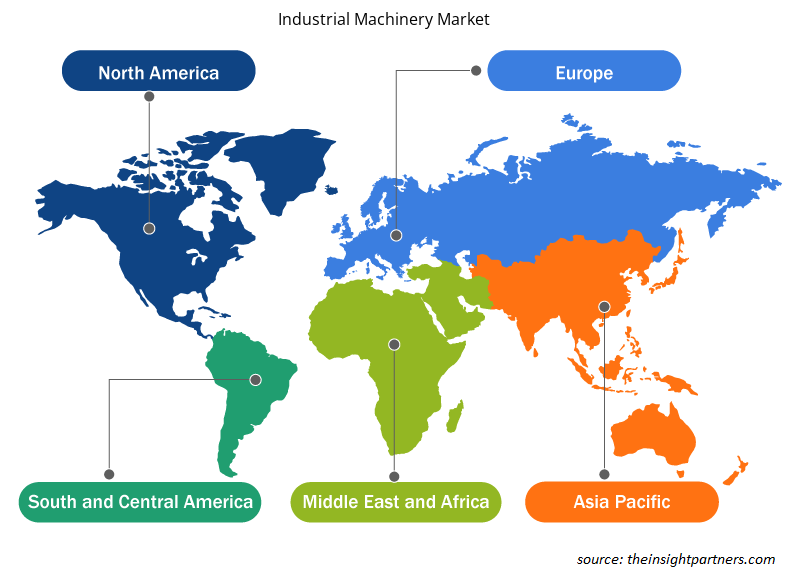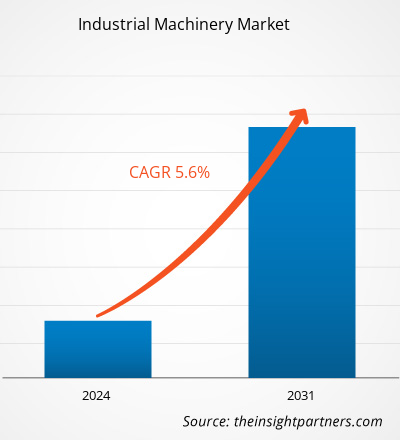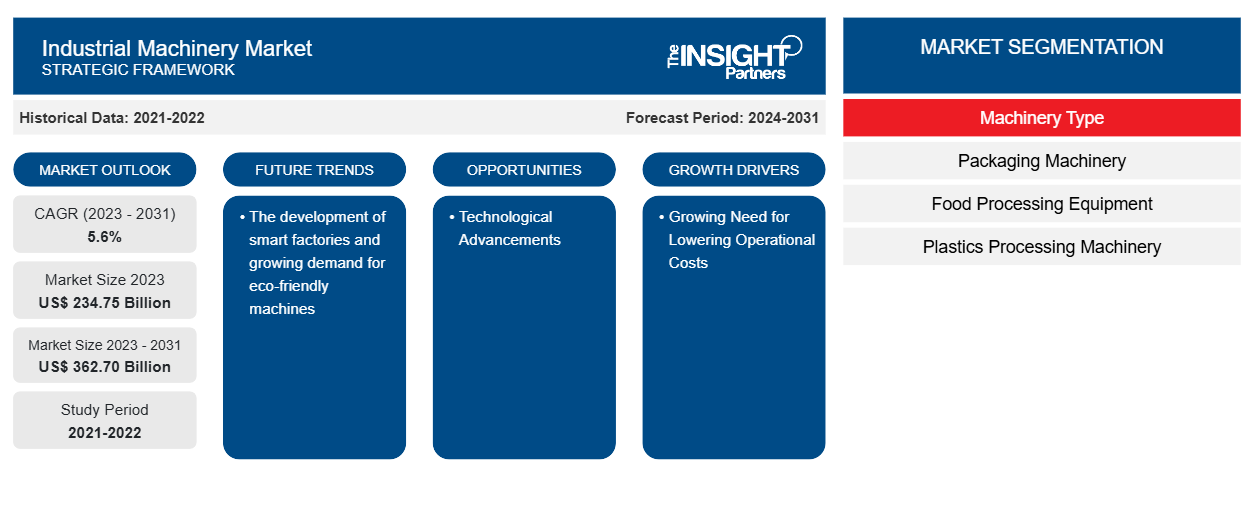Si prevede che la dimensione del mercato dei macchinari industriali raggiungerà i 362,70 miliardi di dollari entro il 2031, rispetto ai 234,75 miliardi di dollari del 2023. Si prevede che il mercato registrerà un CAGR del 5,6% nel 2023-2031. Lo sviluppo di fabbriche intelligenti e la crescente domanda di macchine eco-compatibili rimarranno probabilmente una tendenza chiave del mercato dei macchinari industriali.
Analisi del mercato dei macchinari industriali
Il mercato dei macchinari industriali sta crescendo a un ritmo rapido a causa della crescente necessità di ridurre i costi operativi e della crescente adozione di macchinari industriali da parte dei settori automobilistico, alimentare e delle bevande, farmaceutico, manifatturiero e di altri settori. Il mercato si sta espandendo costantemente, guidato dalla crescente urbanizzazione e automazione industriale . Inoltre, i progressi tecnologici e l'integrazione dell'intelligenza artificiale e della tecnologia di stampa digitale 3D stanno offrendo opportunità redditizie per la crescita del mercato.
Panoramica del mercato dei macchinari industriali
I macchinari industriali si riferiscono a qualsiasi apparecchiatura meccanica, elettrica o elettronica progettata e utilizzata per svolgere una determinata funzione e produrre un risultato specifico. I produttori negli impianti di produzione utilizzano questi macchinari per tagliare, modellare, formare, laminare o coordinare i processi di produzione. I macchinari industriali svolgono un ruolo cruciale nel supportare le attività industriali in tutto il mondo. La crescente digitalizzazione, i progressi tecnologici e le iniziative dell'Industria 4.0 stanno creando opportunità nel mercato.
Personalizza questo report in base alle tue esigenze
Riceverai la personalizzazione gratuita di qualsiasi report, comprese parti di questo report, o analisi a livello nazionale, pacchetto dati Excel, oltre a usufruire di grandi offerte e sconti per start-up e università
-
Scopri le principali tendenze di mercato in questo rapporto.Questo campione GRATUITO includerà analisi di dati che spaziano dalle tendenze di mercato alle stime e alle previsioni.
Driver e opportunità del mercato dei macchinari industriali
La crescente necessità di ridurre i costi operativi sta guidando il mercato
Costi operativi inferiori portano a margini più elevati, consentendo alle aziende di diversificare la propria offerta di prodotti e accedere a nuovi mercati tramite iniziative di riduzione dei costi. La crescente necessità tra le aziende di ridurre i costi operativi aumenta la domanda di macchinari tecnologicamente avanzati. I produttori stanno integrando applicazioni IoT in questi dispositivi per fornire servizi avanzati come monitoraggio remoto, sistemi di feedback centrali e altre funzionalità. Inoltre, i produttori stanno anche adottando sensori avanzati, app mobili e software embedded per semplificare i propri processi operativi riducendo i costi aziendali complessivi, il che sta guidando il mercato.IoT applications into these devices to provide enhanced services such as remote monitoring, central feedback systems, and other features. Moreover, manufacturers are also adopting enhanced sensors, mobile apps, and embedded software to streamline their operational processes by lowering the overall business costs is driving the market.
Progressi tecnologici: un’opportunità nel mercato dei macchinari industriali
Si prevede che rapidi progressi tecnologici guideranno l'innovazione nel mercato dei macchinari industriali durante il periodo di previsione. Inoltre, le industrie manifatturiere stanno adottando tecnologie avanzate come l'intelligenza artificiale, la stampa 3D e l'analisi dei big data per ridurre i costi operativi, migliorare la produttività e ottenere profitti più elevati. Tuttavia, la potenziale integrazione della stampa 3D e della tecnologia AI sta creando opportunità di crescita sia per gli operatori internazionali che nazionali presenti nel mercato dei macchinari industriali.
Analisi della segmentazione del rapporto di mercato dei macchinari industriali
I segmenti chiave che hanno contribuito alla derivazione dell'analisi del mercato dei macchinari industriali sono la tipologia di macchinari.
- In base al tipo di macchinario, il mercato dei macchinari industriali è suddiviso in macchinari per imballaggio, attrezzature per la lavorazione alimentare, macchinari per la lavorazione della plastica, macchine utensili per la formatura dei metalli, macchinari per la lavorazione del legno.
- Il segmento dei macchinari per imballaggio è suddiviso in macchine riempitrici, macchine pallettizzatrici, macchine etichettatrici, macchine confezionatrici e altre. Il segmento delle attrezzature per la lavorazione alimentare è suddiviso in affettatrici e cubettatrici, attrezzature per estrusione, dosatori e miscelatori, attrezzature per stoccaggio e refrigerazione e altre. Il segmento dei macchinari per la lavorazione della plastica è suddiviso in macchine per stampaggio di ispezione, macchine per stampaggio a soffiaggio, macchine per stampaggio a estrusione e altre. Il segmento delle macchine utensili per la formatura dei metalli è suddiviso in macchine a pressione, piegatrici, macchine per fusione, punzonatrici e altre. Il segmento dei macchinari per la lavorazione del legno è suddiviso in torni, rettificatrici, seghe a nastro e altre.
Analisi della quota di mercato dei macchinari industriali per area geografica
L'ambito geografico del rapporto sul mercato dei macchinari industriali è suddiviso principalmente in cinque regioni: Nord America, Asia Pacifico, Europa, Medio Oriente e Africa e Sud America/Sud e Centro America.
In termini di fatturato, l'Asia Pacifica ha rappresentato la quota di mercato più grande per i macchinari industriali, a causa del crescente investimento in progetti infrastrutturali quali trasporti, energia e sviluppo urbano. La crescente necessità di una varietà di attrezzature industriali, quali macchinari edili, attrezzature per movimento terra e attrezzature per la movimentazione dei materiali, sta alimentando il mercato nella regione.
Approfondimenti regionali sul mercato dei macchinari industriali
Le tendenze regionali e i fattori che influenzano il mercato dei macchinari industriali durante il periodo di previsione sono stati ampiamente spiegati dagli analisti di Insight Partners. Questa sezione discute anche i segmenti e la geografia del mercato dei macchinari industriali in Nord America, Europa, Asia Pacifico, Medio Oriente e Africa e America meridionale e centrale.

- Ottieni i dati specifici regionali per il mercato dei macchinari industriali
Ambito del rapporto sul mercato dei macchinari industriali
| Attributo del report | Dettagli |
|---|---|
| Dimensioni del mercato nel 2023 | 234,75 miliardi di dollari USA |
| Dimensioni del mercato entro il 2031 | 362,70 miliardi di dollari USA |
| CAGR globale (2023-2031) | 5,6% |
| Dati storici | 2021-2022 |
| Periodo di previsione | 2024-2031 |
| Segmenti coperti |
Per tipo di macchinario
|
| Regioni e Paesi coperti |
America del Nord
|
| Leader di mercato e profili aziendali chiave |
|
Densità degli attori del mercato dei macchinari industriali: comprendere il suo impatto sulle dinamiche aziendali
Il mercato dei macchinari industriali sta crescendo rapidamente, spinto dalla crescente domanda degli utenti finali dovuta a fattori quali l'evoluzione delle preferenze dei consumatori, i progressi tecnologici e una maggiore consapevolezza dei vantaggi del prodotto. Con l'aumento della domanda, le aziende stanno ampliando le loro offerte, innovando per soddisfare le esigenze dei consumatori e capitalizzando sulle tendenze emergenti, il che alimenta ulteriormente la crescita del mercato.
La densità degli operatori di mercato si riferisce alla distribuzione di aziende o società che operano in un particolare mercato o settore. Indica quanti concorrenti (operatori di mercato) sono presenti in un dato spazio di mercato in relazione alle sue dimensioni o al valore di mercato totale.
Le principali aziende che operano nel mercato dei macchinari industriali sono:
- AB Elettrolux
- Alfa Lavall
- AMADA CO., LTD.
- Gruppo GEA
- INTERNAZIONALE HAITIANO
- MITSUBISHI INDUSTRIA PESANTE, LTD
Disclaimer : le aziende elencate sopra non sono classificate secondo un ordine particolare.

- Ottieni una panoramica dei principali attori del mercato dei macchinari industriali
Notizie e sviluppi recenti del mercato dei macchinari industriali
Il mercato dei macchinari industriali viene valutato raccogliendo dati qualitativi e quantitativi dopo la ricerca primaria e secondaria, che include importanti pubblicazioni aziendali, dati associativi e database. Di seguito è riportato un elenco degli sviluppi nel mercato dei macchinari industriali e delle strategie:
- A novembre 2022, Ingersoll Rand ha lanciato il martello pneumatico 135MAX Heavy Duty per usi industriali. Il martello pneumatico 135MAX HD è il martello pneumatico di nuova generazione che si basa sulle fondamenta stabilite da 119MAX per offrire prestazioni e potenza incredibili a un costo accessibile, sfruttando al contempo un grilletto piumabile finemente regolato ispirato alle leggendarie chiavi a percussione Ingersoll Rand per una maggiore precisione e risultati ancora migliori. (Fonte: Ingersoll Rand, comunicato stampa, 2022)
Copertura e risultati del rapporto sul mercato dei macchinari industriali
Il rapporto "Dimensioni e previsioni del mercato dei macchinari industriali (2021-2031)" fornisce un'analisi dettagliata del mercato che copre le seguenti aree:
- Dimensioni e previsioni del mercato a livello globale, regionale e nazionale per tutti i segmenti di mercato chiave coperti dall'ambito
- Dinamiche di mercato come fattori trainanti, vincoli e opportunità chiave
- Principali tendenze future
- Analisi dettagliata delle cinque forze PEST/Porter e SWOT
- Analisi di mercato globale e regionale che copre le principali tendenze di mercato, i principali attori, le normative e gli sviluppi recenti del mercato
- Analisi del panorama industriale e della concorrenza che copre la concentrazione del mercato, l'analisi della mappa di calore, i principali attori e gli sviluppi recenti
- Profili aziendali dettagliati
- Analisi storica (2 anni), anno base, previsione (7 anni) con CAGR
- Analisi PEST e SWOT
- Valore/volume delle dimensioni del mercato - Globale, Regionale, Nazionale
- Industria e panorama competitivo
- Set di dati Excel
Report recenti
Testimonianze
Motivo dell'acquisto
- Processo decisionale informato
- Comprensione delle dinamiche di mercato
- Analisi competitiva
- Analisi dei clienti
- Previsioni di mercato
- Mitigazione del rischio
- Pianificazione strategica
- Giustificazione degli investimenti
- Identificazione dei mercati emergenti
- Miglioramento delle strategie di marketing
- Aumento dell'efficienza operativa
- Allineamento alle tendenze normative























 Ottieni un campione gratuito per - Mercato dei macchinari industriali
Ottieni un campione gratuito per - Mercato dei macchinari industriali